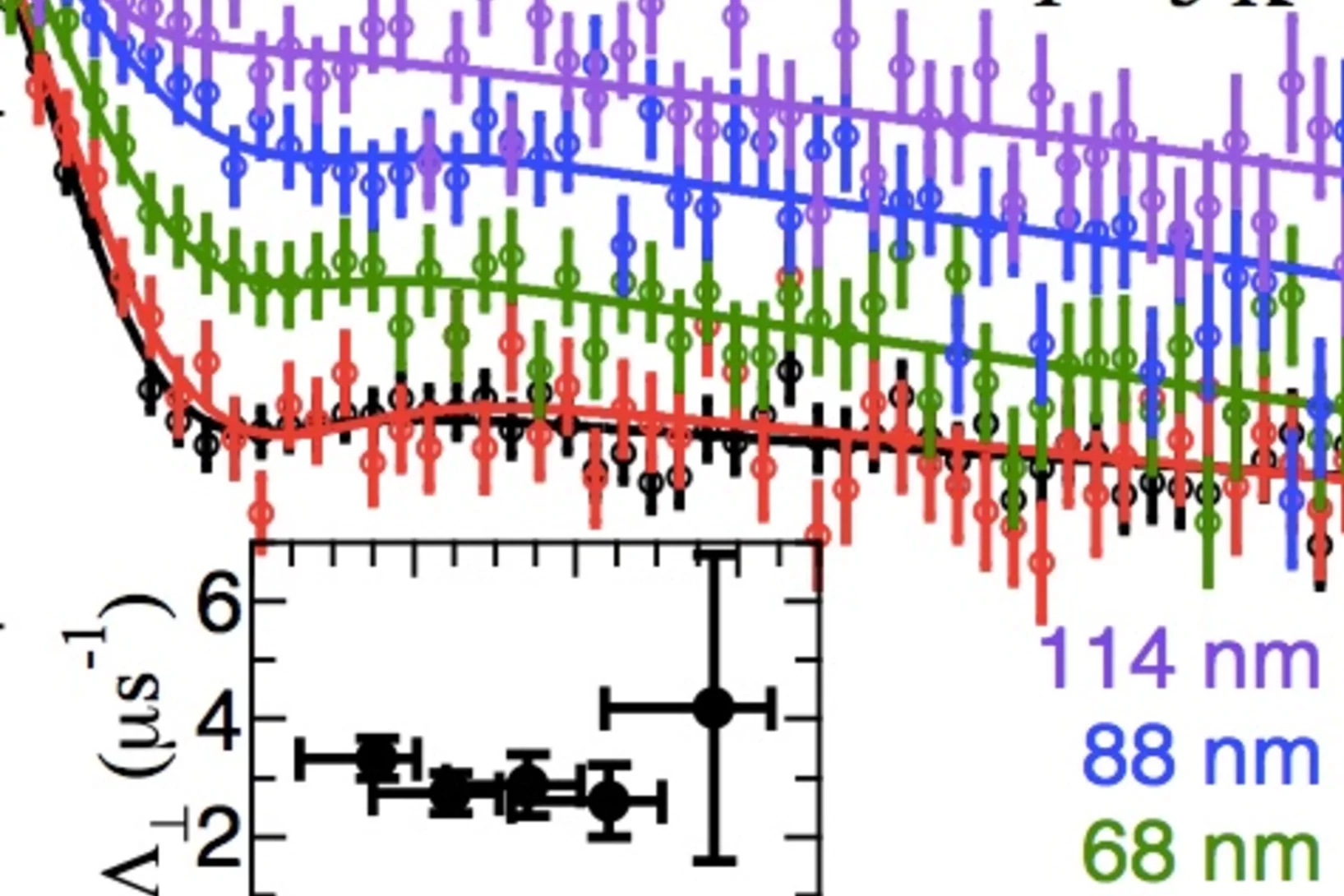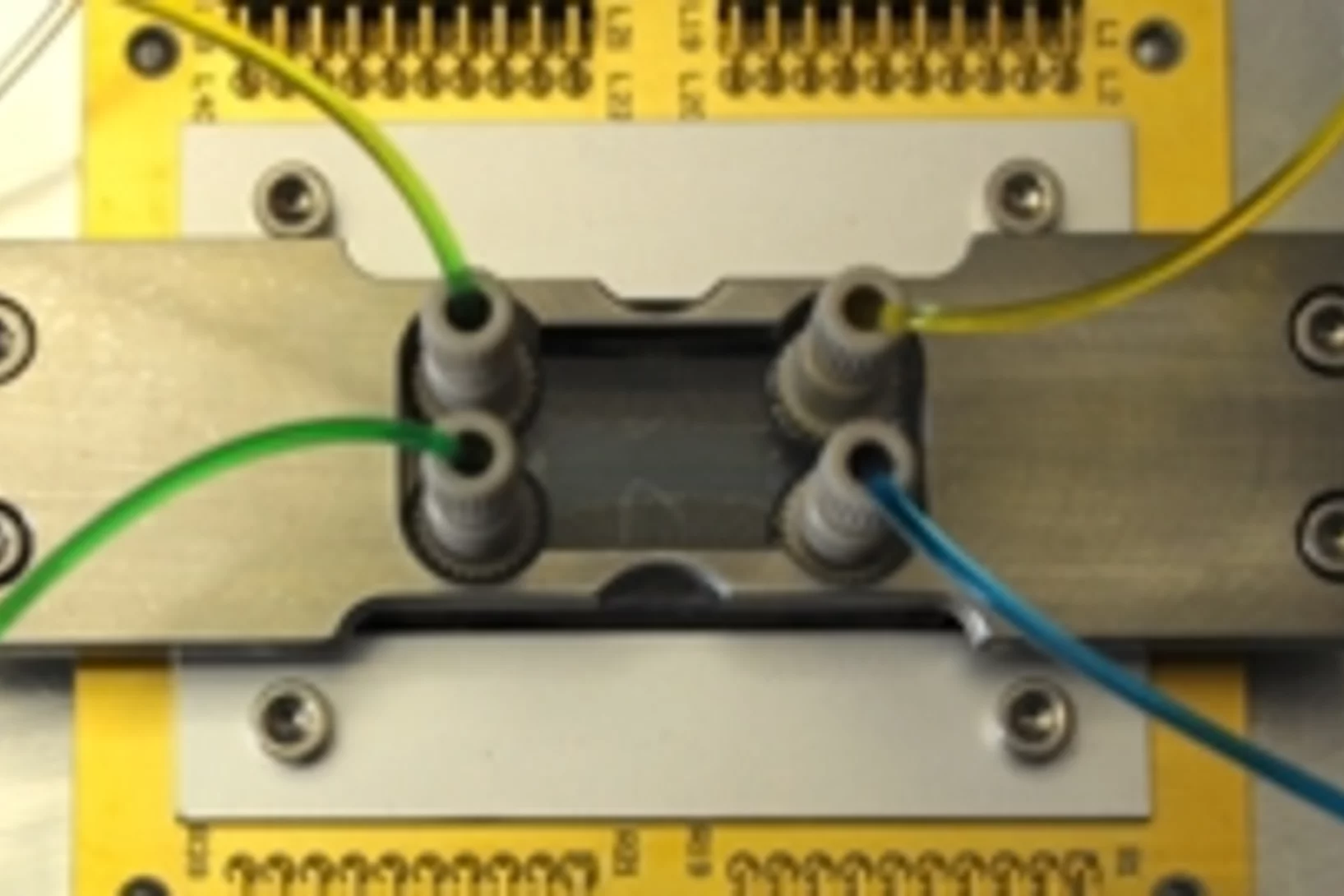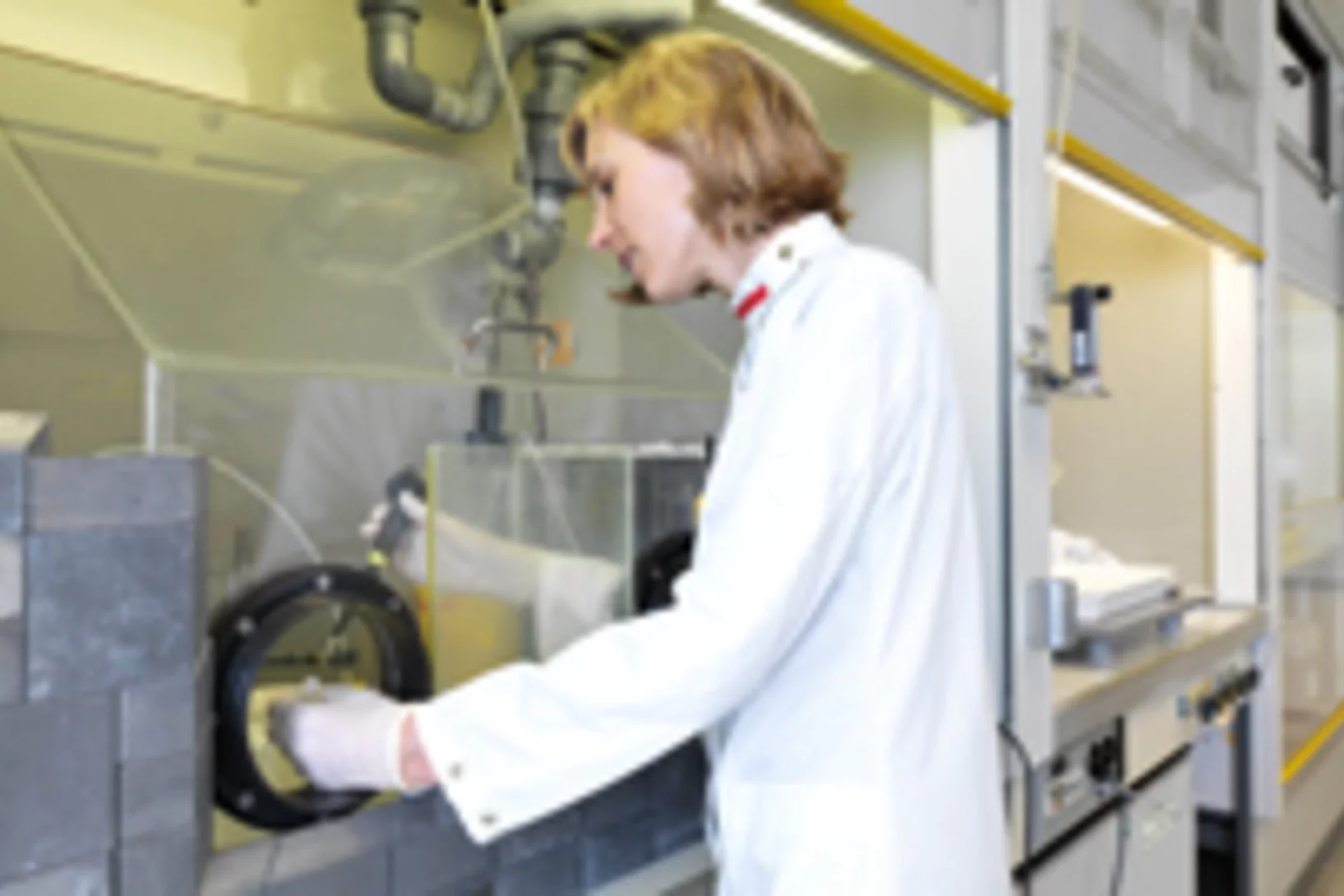Die Energieforschung am PSI konzentriert sich auf Prozesse, die in nachhaltigen und sicheren Technologien für eine möglichst CO2-freie Energieversorgung eingesetzt werden können. Wichtiger Schwerpunkt sind erneuerbare Energien. Auf der Versuchsplattform ESI (Energy System Integration) können Forschung und Industrie Lösungsansätze zur Einbindung erneuerbarer Energien in das Energiesystem testen. Ein weiterer Schwerpunkt des Bereichs ist die sichere Anwendung von Kernenergie. Diese Aktivitäten werden ergänzt durch Analysen zur ganzheitlichen Betrachtung von Energiesystemen. In der Klima- und Umweltforschung werden chemische Prozesse in der Atmosphäre untersucht.
Mehr dazu unter Überblick Energie und Klima
Bulk superconductivity in undoped T'-La1.9Y0.1CuO4 probed by muon spin rotation
The Meissner effect has been directly demonstrated by depth-resolved muon spin rotation measurements in high-quality thin films of the T'-structured cup rate, T'-La1.9Y0.1CuO4, to confirm bulk superconductivity (Tc ≈ 21 K) in its undoped state. The gradual expelling of an external magnetic field is observed over a depth range of ∼ 100 nm in films with a thickness of 275(15) nm, from which the penetration depth is deduced to be 466(22) nm. Based on this result, we argue that the true ground state of the “parent” compound of the n-type cuprates is not a Mott insulator but a strongly correlated metal with colossal sensitivity to apical oxygen impurities.
Supraleitung mit Magnetfeld eingeschaltet
Meist sieht man Supraleitung und Magnetfelder als Konkurrenten à sehr starke Magnetfelder zerstören in der Regel den supraleitenden Zustand. Physiker des Paul Scherrer Instituts PSI haben nun gezeigt, dass in dem Material CeCoIn5 ein neuartiger supraleitender Zustand erst bei starken externen Magnetfeldern entsteht und dann durch Veränderung des Feldes manipuliert werden kann. Das Material ist auch schon bei schwächeren Feldern supraleitend, bei starken Feldern entsteht aber ein zusätzlicher zweiter supraleitender Zustand, so dass gleichzeitig im selben Material zwei unterschiedliche supraleitende Zustände existieren.
Experimente in der Wolke – Wie Russ das Klima beeinflusst
PSI-Forscher Martin Gysel erhält angesehene europäische Förderung (ERC Consolidator Grant) für Untersuchungen zur Rolle von Russ für Wolkenbildung und Atmosphärenerwärmung
Promises of cyclotron-produced 44Sc as a diagnostic match for trivalent beta - emitters: In vitro and in vivo study of a 44Sc-DOTA-folate conjugate
Research Division Biology and Chemistry (BIO), Folate Receptor Targeting Group, Head Cristina Müller. In recent years, implementation of 68Ga-radiometalated peptides for PET imaging of cancer has attracted the attention of clinicians. Herein, we propose the use of 44Sc (half-life = 3.97 h, average β+ energy [Eβ+av] = 632 keV) as a valuable alternative to 68Ga (half-life = 68 min, Eβ+av = 830 keV) for imaging and dosimetry before 177Lu-based radionuclide therapy.
Das Paul Scherrer Institut leitet zwei der Energie-Kompetenzzentren des Bundes
Als Bestandteil der Energiestrategie 2050 haben Bund und Parlament eine verstärkte Förderung der Energieforschung in der Schweiz beschlossen. Dazu gehört die Einrichtung von sieben interuniversitär vernetzten Kompentenzzentren (Swiss Competence Centers in Energy Research SCCER). In den SCCER sollen sich Institutionen aus dem ETH-Bereich, den Universitäten und den Fachhochschulen gemeinsam mit Industriepartnern zusammenschliessen, um neue Kompetenzen und Lösungen in für die Energiewende entscheidenden Aktionsfeldern zu erarbeiten. In zwei SCCER à zu den Themen Speicherung und Biomasse à, die bereits den Zuschlag erhalten haben, ist das Paul Scherrer Institut PSI die federführende Institution. Die beiden Kompetenzzentren werden ihre Arbeit im Jahr 2014 aufnehmen.
Ein Infektionswerkzeug mit metallischem Kern
Dank der Analyse von Proteinproben am PSI konnten Lausanner Forscher zeigen, mit welchem Instrument Bakterien Krankheiten übertragenForscher der ETH Lausanne EPFL haben mit bisher ungekannter Genauigkeit beschrieben, wie ein bestimmter Typ von Bakterien bei der Übertragung von Krankheiten vorgeht. Die Wissenschaftler um Petr Leiman, Assistenzprofessor am Labor für Strukturbiologie und Biophysik der EPFL, konnten zeigen, dass die Spitze des von den Bakterien benutzten Ansteckungswerkzeugs aus einem PAAR-Protein besteht, das ein Metallatom umgibt und spitz zuläuft. Grundlage der Erkenntnisse bilden Messungen an der Synchrotron Lichtquelle Schweiz SLS, einer der drei Grossforschungsanlagen des Paul Scherrer Instituts PSI.
Brennstoffzellenmembran aus dem Paul Scherrer Institut besser als kommerzielle Pendants
Eine neuartige Polymermembran aus dem Paul Scherrer Institut PSI hat im Labortest eine längere Haltbarkeit als die besten kommerziell erhältlichen Pendants gezeigt. Der Durchbruch gelang dank Modifizierung eines preisgünstigen Kunststofffilmes durch Bestrahlung und anschliessendes Aufpfropfen funktioneller Komponenten. Der so veränderte Kunststoff hält nicht nur lange à er könnte die Herstellungskosten der Membran um 50 bis 80 Prozent senken. Anwendung finden könnte die Membran etwa in Wasserstoffbrennstoffzellen oder in Elektrolyseuren zur Wasserstoffherstellung aus Wasser.
Wie Botox an Nervenzellen bindet
Botox ist ein hochgefährliches Gift, das Lähmungen verursacht. In der Kosmetik wird es zur zeitweiligen Beseitigung von Falten und in der Medizin etwa als Mittel gegen Migräne oder zur Korrektur von Strabismus (Schielen) eingesetzt. Ein Forschungsteam hat nun bestimmt, wie das Toxinmolekül an die Nervenzelle bindet, deren Aktivität vom Gift blockiert wird. Die Ergebnisse können nützlich für die Entwicklung verbesserter Medikamente sein, bei denen die Gefahr einer Überdosierung geringer ist als bisher.
Schärferes Bild eines Katalysators mit Ecken und Kanten
Ein Katalysator aus dem Edelmetall Ruthenium auf einem Kohlenstoffträger wird industriell häufig eingesetzt. Ein prominentes Beispiel ist die Synthese von Ammoniak, welches unter anderem zur Herstellung von stickstoffhaltigen Düngemitteln dient. Diesen Katalysatortyp zu optimieren ist das Ziel vieler Forschungsgruppen weltweit, würde dies doch die Effizienz eines der ökonomisch bedeutendsten Industrieprozesse erhöhen. Doch das Verständnis dessen, wie es zum Aufbau der katalytisch aktiven Zentren im Katalysator kommt, ist bisher lückenhaft. Forscher des Paul Scherrer Instituts PSI bringen nun ein paar wichtige Erkenntnisse ans Licht.
Zukünftige Computerchips mit "elektronischem Blutkreislauf"
Im Rahmen des Sinergia-Programms fördert der Schweizerische Nationalfonds das dreijährige Forschungsvorhaben REPCOOL. Unter der Leitung von IBM Research à Zürich arbeiten in diesem Projekt Wissenschaftler der ETH Zürich, des Paul Scherrer Instituts in Villigen und der Università della Svizzera italiana in Lugano gemeinsam an der Erforschung eines elektronischen Blutkreislaufs für zukünftige 3D-Computerchips. Vom menschlichen Gehirn inspiriert, entwickeln die Forscher ein Mikrokanalsystem mit einer elektrochemischen Flussbatterie, die 3D-Chipstapel gleichzeitig kühlen und mit Energie versorgen. Ultimatives Ziel ist die Entwicklung eines Supercomputers in PC-Grösse.
Elektronen mit „gespaltener Persönlichkeit“
Im supraleitenden Material La1.77Sr0.23CuO4 verhält sich oberhalb der Übergangstemperatur ein Teil der Elektronen wie in einem konventionellen Metall, ein anderer Teile wie in einem unkonventionellen à je nach Bewegungsrichtung. Das zeigen Untersuchungen an der SLS. Die Entdeckung dieser Anisotropie liefert einen wesentlichen Beitrag zum Verständnis der Hochtemperatursupraleitung. Ausserdem wird man diesen Effekt in zukünftigen Experimenten und Theorien berücksichtigen müssen.
Die SwissFEL-Anlage: Laserlicht durch lawinenartige Verstärkung
Der SwissFEL wird Röntgenlicht mit Lasereigenschaften erzeugen. Die nötige Verstärkung des Lichts macht ein als Microbunching bekannter Prozess möglich – das Elektronenpaket teilt sich im Undulator in dünne Scheiben, sogenannte Microbunches auf, die das Licht in Phase abstrahlen. Zugleich wird an einem weiteren Verfahren – dem Seeding – geforscht, mit dem man die Eigenschaften des Lichts noch genauer wird festlegen können.
Unique insight into carbon fibers on the nanoscale
The investigation of the mechanical properties of carbon fibers benefits from highly resolved three-dimensional density maps within representative volumes, but such images are not easily obtained with standard methods. Scientists from the Paul Scherrer Institut in collaboration with Honda R&D in Germany have recently visualized density distributions on the sub-micrometer scale within entire carbon fiber sections, revealing surprising graphite distributions within the fibers. This capability will prove useful for the systematic characterization of fibers, contributing to the development of light and robust materials at lower costs.
Magnetismus im Stress: Gleichzeitiger Anti- und Ferromagnetismus
Die gleichzeitige Existenz von Magnetismus und Ferroelektrizät in einem Material ist selten. Setzt sich dieser Magnetismus aus mehreren unabhängigen, magnetischen Grundzuständen zusammen, ist das ungewöhnlich. Einer schweizerisch-französischen Zusammenarbeit unter Leitung des Paul Scherrer Instituts ist es gelungen, mehrere magnetische Grundzustände in einem Material zu realisieren und detailliert zu untersuchen.
Seltene Teilchenzerfälle stützen Standardmodell
Forschende des Paul Scherrer Instituts haben aus den am CMS-Detektor am CERN gemessenen Daten erstmals den sehr seltenen Zerfall des Bs-Mesons in zwei Myonen mit hinreichender Sicherheit beobachtet und seine Häufigkeit bestimmt. Ihre Ergebnisse stimmen sehr gut mit den Voraussagen des Standardmodells der Teilchenphysik überein.
Interface superconductor with gap behaviour like a high-temperature superconductor
The physics of the superconducting state in two-dimensional (2D) electron systems is relevant to understanding the high-transition-temperature copper oxide superconductors and for the development of future superconductors based on interface electron systems. But it is not yet understood how fundamental superconducting parameters, such as the spectral density of states, change when these superconducting electron systems are depleted of charge carriers.
Neues Diagnoseverfahren bei Brustkrebs vielversprechend
Ein neues Mammografie-Verfahren könnte laut einer soeben veröffentlichten Studie einen deutlichen Mehrwert für die Diagnose von Brustkrebs in der medizinischen Praxis bringen. Die am PSI in Zusammenarbeit mit dem Brustzentrum des Kantonsspitals Baden und dem Industriepartner Philips entwickelte Methode macht bereits kleinste Gewebeveränderungen besser sichtbar. Dies könnte potenziell die Früherkennung von Brustkrebs verbessern. Zukünftig sollen Studien an Frauen mit einer Brustkrebserkrankung den Mehrwert der Methode endgültig belegen.
Mit Röntgenstrahlen der Lebensdauer von Lithium-Ionen-Akkus auf der Spur
Mithilfe von Röntgen-Tomographie haben Forschende die Vorgänge in Materialien von Batterie-Elektroden detailliert untersuchen können. Anhand hochaufgelöster 3D-Filme zeigen sie auf, weshalb die Lebensdauer der Energiespeicher begrenzt ist.
PSI-Forscherin Helena Van Swygenhoven erhält angesehene Europäische Förderung (ERC Grant)
Helena Van Swygenhoven, Werkstoffforscherin am Paul Scherrer Institut und Professorin an der ETH Lausanne (EPFL), erhält einen ERC Advanced Grant. Diese angesehene Förderung des Europäischen Forschungsrates in Höhe von 2,5 Millionen Euro wird es ihr ermöglichen, das neues Forschungsprojekt MULTIAX zu begründen. In diesem Projekt wird sie Vorgänge bei der Verformung von metallischen Werkstoffen untersuchen, die zum Beispiel für die Herstellungsprozesse von Autoteilen wichtig sind. Zusätzlich werden in dem Projekt neuartige Verfahren zur Untersuchung von Werkstoffen entwickelt, die dann auch anderen Forschenden zur Verfügung stehen werden.
Die Ursprünge der ersten Fische mit Zähnen
Mit Hilfe von Röntgenlicht aus der Synchrotron Lichtquelle Schweiz des PSI ist es Paläontologen der Universität Bristol gelungen, ein Rätsel um den Ursprung der ersten Wirbeltiere mit harten Körperteilen zu lösen. Sie haben gezeigt, dass die Zähne altertümlicher Fische (der sogenannten Conodonten) unabhängig von den Zähnen und Kiefern heutiger Wirbeltiere entstanden sind. Die Zähne dieser Wirbeltiere haben sich vielmehr aus einem Panzer entwickelt, der dem Schutz vor den Conodonten, den ersten Raubtieren, diente.
Ein Blick in die Zukunft der globalen Energieversorgung
Wie wird sich die Welt im Jahr 2050 mit Energie versorgen und was werden die ökonomischen, ökologischen und sozialen Folgen verschiedener Entwicklungsziele und politischer Rahmenbedingungen sein? Diese Fragen beantworten Forscher des Paul Scherrer Institus PSI in Zusammenarbeit mit dem Weltenergierat WEC durch eine Untersuchung von zwei Szenarien, einem eher marktwirtschftlich und einem eher regulatorisch orientierten. Die Ergebnisse der nun abgeschlossenen Untersuchung werden vom 13. bis 17. Oktober am World Energy Congress des WEC in der südkoreanischen Stadt Daegu präsentiert werden
Mit Vitamin gegen Krebs
Cristina Müller vom Zentrum für Radiopharmazeutische Wissenschaften forscht an einer Therapie mit radioaktiv markierten Folsäure-Verbindungen. Diese gelangen wie ein Trojanisches Pferd ungehindert in die Zelle und töten diese dann mit ihrer Strahlung ab, erklärt sie.
Partikelbildung in der Atmosphäre
Wolken bestehen aus Wolkentröpfchen, die sich aus winzigen Partikeln bilden, die in der Atmosphäre schweben. Wie diese Partikel entstehen, ist in grossen Teilen noch nicht verstanden. Nun gelang erstmals die Beschreibung der Partikelbildung aus Aminen und Schwefelsäure. Ein Meilenstein in der Atmosphärenforschung.
Die Sicherheitskultur gestalten
Sabine Mayer leitet seit Anfang Jahr die Abteilung Strahlenschutz und Sicherheit ASI und ist somit zuständig für die Gewährleistung der Sicherheit am PSI von der Betriebsfeuerwehr über die Arbeitssicherheit bis zur radiologischen Überwachung. Doch die Bedeutung der Abteilung reicht über das PSI hinaus: die Schweizerischen Behörden vertrauen ihrem Pool an Fachleuten, so dass sie die Sicherheitskultur in der Schweiz mitprägt. Ein Interview.
Ein entscheidender Zerfall
Ein seltener Vorgang in der Natur soll darüber entscheiden, wie wir in Zukunft am besten unser Universum beschreiben. Es handelt sich um einen bestimmten Zerfall einer bestimmten Elementarteilchensorte: der Myonen. Diese Teilchen leben nicht lange und zerfallen in verschiedene andere Partikel. Doch ein ganz besonderer Zerfallsprozess ist laut den einen theoretischen Modellen praktisch verboten, laut den anderen aber erlaubt. Welche Theorie hat recht? Durch die genaueste Beobachtung von vielen hundert Billionen Teilchenzerfällen sind Physiker am Paul Scherrer Institut diesem Rätsel näher gekommen. Ihre Ergebnisse haben sie im Fachblatt Physical Review Letters veröffentlicht.
Auf dem Weg zu Natrium-Ionen-Batterien
Natriumdynamik auf mikroskopischem Niveau verstehenLithium-Ionen-Batterien sind sehr leistungsstark, doch die Nutzung von Lithium hat Nachteile: es ist teuer und seine Gewinnung belastet die Umwelt. Eine Möglichkeit, diese Nachteile zu umgehen, wäre statt Lithium Natrium zu verwenden. Um eine Natrium-Ionen-Batterie zu bauen, muss man verstehen, wie sich die Natrium-Ionen in den entsprechen Materialien bewegen. Forschende des Paul Scherrer Instituts haben nun erstmals die Pfade bestimmt, auf denen sich Natrium-Ionen in einem möglichen Batterie-Material bewegen. Mit diesem Wissen kann man überlegen, wie man durch geringe Änderungen der Struktur oder der Zusammensetzung neue Materialien erzeugen kann, die Eigenschaften haben, wie sie in zukünftigen Batterien gebraucht würden.
Computersimulationen: wichtige Stütze für die KKW-Sicherheit
Ohne Computersimulationen wäre der Betrieb von Kernkraftwerken kaum möglich. Ob es um den Einbau neuer Komponenten oder um Tests und Versuche zur Wahrung der Sicherheit geht, fast alles muss vorher am Computer im Voraus berechnet und analysiert werden. Im Labor für Reaktorphysik und Systemverhalten des Paul Scherrer Instituts PSI werden dafür Rechenmodelle und Computerprogramme entwickelt. Die PSI-Forscher fungieren damit als unabhängige Forschungspartner der Aufsichtsbehörde, des Eidgenössischen Nuklearsicherheitsinspektorats ENSI, und leisten so einen wichtigen Beitrag zur Gewährleistung der Sicherheit von schweizerischen Kernkraftwerken.
Eine runde Sache für weniger nuklearen Abfall
Bereits in den 1960er Jahren entstand die Idee, die Brennstoffe für Kernkraftwerke in Form von dicht gepackten Kugeln statt der heutigen üblichen Pellets herzustellen. Man versprach sich davon eine Vereinfachung der Brennstoffherstellung sowie eine deutliche Verminderung der radioaktiven Abfallmenge sowohl bei der Herstellung des Brennstoffs selbst als auch nach dessen Nutzung in einem Kernkraftwerk. Der kugelförmige Brennstoff kam jedoch nie zum Einsatz, weil sich die schnellen Reaktoren, für die er vorgesehen war, nicht durchsetzen konnten. Auch das Paul Scherrer Institut PSI trug in der Vergangenheit zur Erforschung des kugelförmigen Kernbrennstoffes bei. Zurzeit laufen am PSI wieder mehrere, zum Teil EU-finanzierte Projekte, um die Herstellung der Brennstoffkügelchen weiter zu verfeinern. Zum Einsatz kommen könnte diese Art von Brennstoff entweder in speziellen Anlagen zur Reduktion von radioaktivem Abfall (sogenannten ADS-Anlagen) oder in schnellen Reaktoren der vierten Generation, die in einem geschlossenen Zyklus ebenfalls weniger langlebigen Abfall produzieren.
Neutronen und Synchrotronlicht helfen bronzezeitliche Arbeitstechniken zu entschlüsseln
Untersuchungen am PSI haben es möglich gemacht, zu bestimmen, wie ein einzigartiges bronzezeitliches Beil hergestellt worden ist. Zu verdanken ist das dem Verfahren der Neutronentomografie, mit der man ein genaues dreidimensionales Abbild des Inneren eines Gegenstandes erzeugen kann. Seit einem Jahrzehnt kooperiert das PSI erfolgreich mit verschiedenen Museen und archäologischen Institutionen im In- und Ausland. Es ist ein deutliches Zeichen der etablierten Kooperation, dass der 18. Internationale Kongress über Antike Bronzen, der vom 3. - 7. September 2013 an der Universität Zürich stattfindet, auch einen Tag am PSI tagt.
Rekonstruktion des Nuklearunfalls von Fukushima
Forscher des Paul Scherrer Instituts PSI beteiligen sich zurzeit an einem internationalen Projekt mit dem Ziel, die Vorgänge zu rekonstruieren, die sich beim Nuklearunfall vom März 2011 im Inneren der Reaktoren des japanischen Kernkraftwerks Fukushima Daiichi ereigneten. Insbesondere die Rekonstruktion des Endzustandes der Reaktorkerne soll dem Betreiber des havarierten Werkes, der Tokyo Electricity Company TEPCO dabei helfen, die Dekontaminierungsarbeiten in der Reaktorschutzhülle vorzubereiten. Zudem soll die Übung auch zur weiteren Verfeinerung der Computerprogramme beitragen, mit deren Hilfe Nuklearunfälle simuliert werden.






























